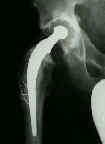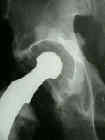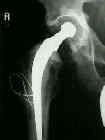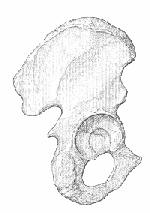
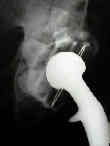
- See: Total Hip Replacement Menu:

- cementless components
- cement technique
- acetabular component revision
- operative considerations for hip dyplasia
- protrusio
- Discussion:
- technical considerations:
- in the report by Crites BM, et al (2000), the effect of porosity reduction
cementing techniques with respect to radiolucent lines in Zone 1 and failure in acetabular components was studied
in 2237 consecutive cemented acetabular components done between 1970 and 1998.
- porosity reduction techniques did not reduce the incidence of Zone 1 radiolucencies;
- factors that were considered essential included:
- reaming through the subchondral bone to achieve a good cancellous bone bed;
- perforation and removal of peripheral sclerotic areas;
- dry cancellous bone bed
- pressurization of the entire cement mantle in the socket at one time;
- complete burying of the acetabular component within the boundary of the bony acetabulum;
- ref: Technical Considerations of Cemented Acetabular Components A 30-Year Evaluation.
- special situations:
- cement resurfacing for fracture:
- Secondary total hip replacement after fractures of the femoral neck.
- Bone impaction grafting and a cemented cup after acetabular fracture at 3-18 years.
- [The chronic central fracture dislocation of the hip]
- impaction bone grafting: (bone grafting for THR)
- [Reconstruction of acetabular defect with wire mesh and impacted bone graft in cemented acetabular revision]
- Acetabular Reconstruction with Impaction Bone-Grafting and a Cemented Cup in Patients Younger Than Fifty Years Old: A Concise Follow-up, At Twenty to Twenty-eight Years, of a Previous Report.
- Acetabular revision with impacted morselized cancellous bone graft and a cemented cup in patients with rheumatoid arthritis: three to fourteen-year follow-up.
- Acetabular revision with morsellised allogenic bone graft and a cemented metal-backed component.
- Acetabular reconstruction with impacted bone allografts and cemented acetabular components: a 2- to 13-year follow up of 142 aseptic revisions.
- Acetabular reconstruction with impacted morsellised cancellous bone graft and cement. A 10-to 15-year follow up of 60 revision arthroplasties.
- Particle size of bone graft and method of impaction affect initial stability of cemented cups: human cadaveric and synthetic pelvic specimen studies.
- Acetabular revision with impacted morsellised cancellous bone grafting and a cemented cup. A 15- to 20-year follow-up.
- [Reconstruction of the Acetabulum with Structured Bone Graft in Press-Fit Technique].
- Technique:
- acetabular exposure, estabilishment of acetabular floor, and reaming are carried out in the usual manner;
- need to ream through the subchondral bone to achieve a good cancellous bone bed;
- perforation and removal of peripheral sclerotic areas;
- references:
- Is removal of subchondral bone plate advantageous in cemented cup fixation? A randomized RSA study
- drill holes:
- multiple (five to eight) 5-mm-diameter countersink holes were placed throughout the acetabulum;
- Fixation of the acetabular cup in cemented total hip replacement: improving the anchorage hole profile using finite element method.
- Optimizing the configuration of cement keyholes for acetabular fixation in total hip replacement using Taguchi experimental design.
- Configuration of anchorage holes affects cemented fixation of the acetabular component in total hip replacement - An in vitro study.
- bone grafting for acetabular defects;
- cancellous bone chips with a diameter of 0.7 to 1.0 cm were created
- segmental defects in the medial wall or peripheral defects of the acetabulum are closed with a slice of corticocancellous bone or with metal mesh;
- a trial acetabular prosthesis (w/ mallet) are impacted against the bone grafts.
- need to restore the original center of rotation of the hip, (use transverse ligament as a reference);
- consider directly cementing the graft at the reconstruction site;
- references:
- Particle size of bone graft and method of impaction affect initial stability of cemented cups: human cadaveric and synthetic pelvic specimen studies.
- Sealing the acetabular notch in cemented total hip arthroplasty. A radiological review of 380 cases
- cement technique:
- achieve a dry cancellous bone bed (hypotensive anesthesia);
- pressurization of the entire cement mantle in the socket at one time;
- Acetabular cement compactor. An experimental study of pressurization of cement in the acetabulum in total hip arthroplasty
- In Vitro Pressurization of the Acetabular Cement Mantle: the Effect of a Flange
- Migration of the acetabular component: effect of cement pressurization and significance of early radiolucency: a randomized 5-year study using radiostereometry.
- complications:
- note that exothermic reaction (and ensuing heat) that occurs during cement hardening may injure soft tissue structures opposite of
acetabulum (especially when the acetabulum is thin);
- component loosening:
- patients may or may not show symptoms from cemented cup loosening;
- radiographic demarcation of the bone cement interface on immediate postoperative x-rays is a strong risk factor for early component loosening;
- as noted by Garcia-Cimbrello, et al (1997), 13 of 18 cups with a complete radiolucent line on initial radiographs migrated;
- as noted by Kavanaugh and Fitzgerald (1987), 70% of cemented acetabular revisions developed progressive radiolucencies;
- these authors noted a 10% failure rate at 2 years;
- references:
- The mechanism of loosening of cemented acetabular components in total hip arthroplasty. Analysis of specimens retrieved at autopsy.
- Progression of radiolucent lines adjacent to acetabular component and factors influencing migration after Charnley low friction total hip arthroplasty.
- Multiple revisions for failed total hip arthroplasty not associated with infection.
- Failure of the Mecring screw-ring acetabular component in total hip arthroplasty. A three to seven-year follow-up study.
- Loosening of the cemented hip prosthesis. The importance of heat injury.
- Early migration of acetabular components revised with cement. A roentgen stereophotogrammetric study.
- References:
Current status of acetabular fixation in primary total hip arthroplasty.
The role of cemented sockets in 2004: is there one?
Fixation of the acetabular component. The case for cement
Cemented cup revisions.
Acetabular reconstruction with bone impaction grafting and a cemented cup: 20 years' experience.
Multiple revision for failed total hip arthroplasty not associated with infection.
An improved acetabular cementing technique in total hip arthroplasty. Aspiration of the iliac wing.


